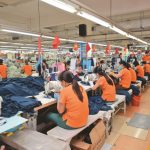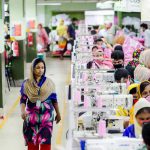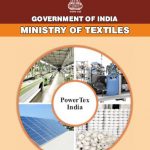 Chairman of the Viet Nam National Textile and Garment Group (VINATEX) Vu Duc Giang spoke to the media about the progress of garment exports on the sidelines of the International Textile Manufactures Federation (ITMF) annual conference, themed “Challenges for the Textile Industry – Present and Future” held recently in Ha Noi. Excerpts :
Chairman of the Viet Nam National Textile and Garment Group (VINATEX) Vu Duc Giang spoke to the media about the progress of garment exports on the sidelines of the International Textile Manufactures Federation (ITMF) annual conference, themed “Challenges for the Textile Industry – Present and Future” held recently in Ha Noi. Excerpts :
Viet Nam hosted the ITMF annual conference this year. How important is the the conference to the development of the domestic garment industry?Large international businesses have trust in Viet Nam due to its political stability and this has encouraged investments which are revolutionising the garment industry.
The shift from performing outwork to free-on-board (FOB) practice and reducing the nation’s raw material imports from 100 per cent to 60-65 per cent has also brought opportunities to expand co-operation with foreign partners.
As a result of these achievements, ITMF chose Viet Nam to host this year’s annual meeting. It is considered a triumph for the domestic garment and textile sector in particular, and Vietnamese industry in general.
What measures are being pushed to attract foreign direct investment into the supportive industries?
This year’s conference was an excellent chance for Vietnamese enterprises to call for investment and production support, while sharing experiences with enterprises from around the world. During this period, we worked with the China Association of Textile and Apparel to discuss eight strategic issues between the two countries’ associations. At the conference, Viet Nam also appealed for investment from foreign textile manufacturers in this key industry, partcularly towards high-grade products.
What goals have been set for the garment industry?
As of September, garment exports had reached US$12.6 billion and a target of $17 billion is set for the full 2012 year, an increase of about 7.7-8 per cent on last year. But the progress is still far behind that of many garment and textile enterprises around the world.
This year’s ITMF conference was the launchpad for Viet Nam to achieve goals set for the 2013-15 period with a vision towards 2020-30, providing the catalyst for the production of raw materials and core products. It also impacts the value chain from thread, weaving and dying to sewing. The annual growth was expected to accelerate in 2014-15 and 2025-30, providing the impetus for increased production and foreign investment. The industry has set goals of boosting exports to $20-21 billion next year, with production aimed to be in line with job creation schemes and social security for workers. The goal of $25 billion in garment exports for 2015, is also achievable.
In January next year, the Viet Nam Textile and Apparel Association will join an international conference of fashion designers in China. Viet Nam is the sixth member to join the Asia Fashion Federation and it also aims to become the third or second largest garment exporter during the 2017-20 period.
What are the major challenges for the garment and textile industry?
I think all industries have their own challenges and the garment sector is no exception to this. Our duty to overcome those challenges must tackle four key issues. Firstly, long-term targets and strategy must be identified, specifically for our core products. Fibre-weaving-dyeing process and middle and high-grade products are included in these targets. The second task is to keep abreast with market developments while making recommendations to the National Assembly, Government and ministries to create stable and long-term mechanisms for both domestic and FDI enterprises. Next, we need to create favourable conditions for investment with a long-term investment plan that will provide jobs for localities and stability for enterprises. VINATEX, for example, has worked with many localities to plan their cotton and material-planting areas. Finally, in parallel with producing, we have to introduce our products and trademarks to the world market. The garment sector aims to achieve 5 to 7 per cent world market penetration for Vietnamese brand names by 2020.





